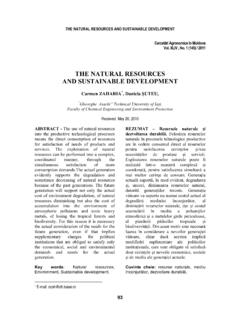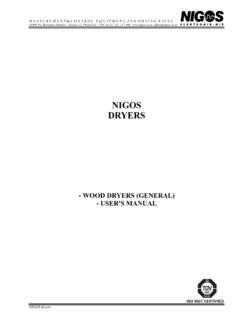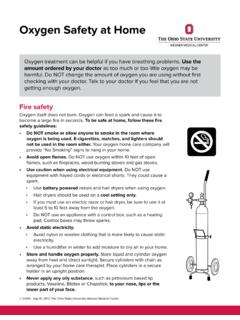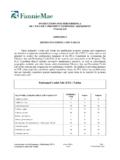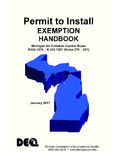Transcription of WATER ABSORPTION CHARACTERISTICS OF THREE …
1 WATER ABSORPTION IN THREE WOOD VARIETIES 5 Cercet ri Agronomice n Moldova Vol. XLI , No. 2 (134) / 2008 WATER ABSORPTION CHARACTERISTICS OF THREE WOOD VARIETIES J. KHAZAEI* University of Tehran, Iran Received November 23, 2007 ABSTRACT - WATER ABSORPTION process during wood soaking in WATER was studied on THREE varieties of wood. Two models were considered to describe the kinetics: the Peleg model and a new one based on the viscoelastic properties of materials. The soaking data were fitted to the Fick s model to determine WATER diffusivity.
2 The pattern of WATER uptake suggested a two step- process, in which more than half of the final absorbed WATER occurred in the first two days of liquid WATER contact with wood. This was followed by a period of very slow WATER uptake. The mean values of WATER ABSORPTION at initial stages of moisture sorption for Afra, Ojamalesh and Roosi genotypes were equal to , and (kg/m2 s1/2), respectively. The corresponding mean values of this parameter for the entire soaking process were equal to , and (kg/m2 s1/2), respectively.
3 The calculated diffusion coefficients for Afra, Ojamlesh, and Roosi wood varieties were , , and m2/s, respectively. The newly introduced model was more accurate for describing the WATER ABSORPTION CHARACTERISTICS of wood samples. The maximum value of root-mean-square deviation was , which demonstrated the suitability of the new model for modelling the experimental ABSORPTION CHARACTERISTICS of wood samples. Key words: wood, WATER ABSORPTION , modelling, diffusivity, Fick s law REZUMAT Caracteristicile de absorb ie a apei la trei specii de lemn.
4 Absorb ia apei la trei specii de lemn a fost studiat n timpul procesului de nmuiere a lemnului n ap . Pentru aceasta, s-au folosit dou modele: modelul Peleg i un model nou, bazat pe propriet ile viscoelastice ale materialelor. Datele privind nmuierea au fost adaptate la modelul Fick, pentru determinarea caracterului de difuzie a apei. Modelul de absorb ie a apei a implicat un proces n dou etape, n care mai mult de jum tate din ap a fost absorbit in primele dou zile de contact al lichidului cu lemnul.
5 Apoi, a urmat o perioad de absorb ie foarte lent a apei. Valorile medii ale absorb iei apei, n stadiile ini iale, de c tre genotipurile Afra, Ojamalesh i Roosi, au fost egale cu , i, respectiv, (kg/m2 s1/2). Valorile medii * E-mail: J. KHAZAEI 6 corespunz toare ale acestui parametru, pe durata ntregului proces de nmuiere, au fost de , i, respectiv, (kg/m2 s1/2). Coeficien ii de difuzie, calcula i pentru speciile de lemn Afra, Ojamlesh i Roosi, au fost de , i, respectiv, m2/s.
6 Modelul nou a fost mai precis n descrierea caracteristicilor de absorb ie a apei de c tre speciile de lemn. Valoarea maxim a devia iei r d cinii medii p trate a fost de , ceea ce a demonstrat precizia noului model de modelare a caracteristicilor experimentale de absorb ie a apei de c tre lemn. Cuvinte cheie: lemn, absorb ia apei, modelare, difuzie, legea lui Fick INTRODUCTION Wood in storage is exposed to both periodic WATER ABSORPTION and desorption processes. The WATER ABSORPTION by wood frequently assumes great importance, especially in the structural uses of wood (Baronas et al.)
7 , 2001). In residential buildings and in industrial applications, some components are often wood or wood-based (Candanedo and Derome, 2005). These components are exposed to the contact with liquid WATER , for example wetted by rain or by WATER infiltration. Thus, wood is always undergoing changes in moisture content. Understanding WATER ABSORPTION by wood during soaking is of practical importance, since it affects the mechanical properties of the product. The effects of moisture content on the mechanical properties of wood have been the subject of an intense investigation worldwide (Gerhards, 1998; Obataya et al.
8 , 1998; Severa et al., 2003). All strength properties decrease as wood adsorbs moisture in the hygroscopic range. Important properties such as modulus of rupture and compressive strength parallel to gram may decrease up to 4 and 6 percent, respectively, for each percent increase in moisture content (Bendtsen, 1966). The periodic WATER ABSORPTION has also a negative effect on wood quality. The ability of microorganisms to attack wood depends on the moisture content of the wood cell wall (Baronas et al.
9 , 2001). Hence, modelling WATER transfer in wood during soaking has attracted considerable attention. The amount of absorbed WATER in wood is dependent on the density and WATER diffusivity of wood. The WATER diffusivity coefficient describes the rate at which WATER moves from surface to the interior of products. These effects are caused by the porous structure of wood and the reactivity of its chemical components. Few measurements have been done on the wetting of wood and, as a result, few models have been developed with the capacity to simulate moisture uptake by wood.
10 The data obtained from WATER ABSORPTION or sorption tests can provide a good approximation of the average liquid WATER diffusivity of the material (Malkov et al., 2004; Kumaran, 1999). One of the most important aspects of wood technology is modelling of the WATER ABSORPTION processes. The process modelling is of unquestionable importance for the design and operation of dryers and other processing systems. WATER ABSORPTION IN THREE WOOD VARIETIES 7 The evaluation of WATER ABSORPTION kinetics could help us in WATER ABSORPTION simulation for predicting the suitable ABSORPTION conditions.

